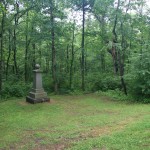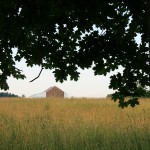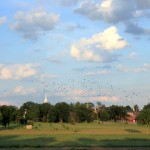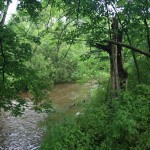 Among the first units of the Army of the Potomac to pass into Pennsylvania on June 30th, 1863, the Iron Brigade enjoyed the cheering crowds and free food from grateful civilians that Robert E. Lee’s “Army of Liberation” had been expecting but never saw. The men that made up the Brigade — of the 2nd, 6th and 7th Wisconsin, the 19th Indiana, and the 24th Michigan — spent the night camped where Marsh Creek crosses the Emmitsburg Road (this area today is a non-descript dip in Highway 15, but if you know what to look for, you can find it). Members of the 19th Indiana pulled picket duty on the northern border of the camp, and found themselves the very tip of the spear of the Union Army, the furthest north and closest to the enemy. A few of the men on picket duty noticed a prominent hill in the distance that passing locals identified as Big Round Top, just outside of the town of Gettysburg.
Among the first units of the Army of the Potomac to pass into Pennsylvania on June 30th, 1863, the Iron Brigade enjoyed the cheering crowds and free food from grateful civilians that Robert E. Lee’s “Army of Liberation” had been expecting but never saw. The men that made up the Brigade — of the 2nd, 6th and 7th Wisconsin, the 19th Indiana, and the 24th Michigan — spent the night camped where Marsh Creek crosses the Emmitsburg Road (this area today is a non-descript dip in Highway 15, but if you know what to look for, you can find it). Members of the 19th Indiana pulled picket duty on the northern border of the camp, and found themselves the very tip of the spear of the Union Army, the furthest north and closest to the enemy. A few of the men on picket duty noticed a prominent hill in the distance that passing locals identified as Big Round Top, just outside of the town of Gettysburg.
The men had been told by those in charge that there were no Confederates about, and not to expect action on July 1st, but a detachment of John Buford’s cavalry passed through the camp late on the 30th and the horsemen spoke of going to greet some enemy infantry just down the road. Elements of Buford’s cavalry had fought with the brigade throughout the past year, and the Iron Brigade soldiers trusted their take on events more than any general’s. The troopers rode off to the north, out of sight down the meandering Emmitsburg Road; it would be less than 12 hours before the two groups would meet again, all fighting for their lives.
The Iron Brigade rose with the sun on July 1st, and saw Buford’s trooper’s words reinforced with an issue of 90 rounds of ammunition for each man. In one of the more ominous portents of the day to come, soldiers in the 19th Indiana wrote of watching men of the 24th Michigan in the morning mist, kneeling in prayer with the unit’s chaplain, as others handed them their ammunition allotment.
The units set off as soon as they formed up. As they neared Gettysburg, Rufus Dawes, commander of the 6th Wisconsin, had the unit’s band strike up a song. Even though many credit the 6th’s band as being one of the worst groups ever to assault musical instruments, the men joined in singing. As they continued on, the intermittent crack of rifle fire was heard ahead. At the Codori farm, fences were torn down, baggage and horses left behind, and the unit struck out across the fields towards the cupola of the Lutheran seminary to the north-west.
The cavalry troopers that had passed through the Iron Brigade’s camp the night before were arrayed in a north to south line, just past the Lutheran seminary. They’d been fighting a delaying action against a large Confederate infantry force moving on the town* since that morning: dismounting and firing volleys at the approaching enemy, falling back several  yards, and firing again. They’d been at it for hours and were at the limits of their endurance.
yards, and firing again. They’d been at it for hours and were at the limits of their endurance.
The closer they got to the fighting , the faster the men of the Iron Brigade moved. By the time they reached the seminary grounds and turned towards the now incessant firing at nearby McPhearson’s ridge, they were at a full run. No time for the usual methodical loading of the weapons before entering battle, the lines staggered as the men went forward at the double-quick, trying to maintain their alignment with the men on either side of them as they loaded their rifle, and fixed their bayonet.
The unit came through a waist-high wheat field and upon the Union cavalry that still resisted the large mass of Confederate infantry. They passed through their thin lines and immediately fired a devastating volley into the startled Confederates who had only expected to encounter cavalry and local militia. Volleys rang back and forth over the next hour or so, and at the end Union forces captured hundreds of Confederate prisoners, including a general, and over 400 rifles. Prisoners were quickly sent to the rear, and rifles that couldn’t be sent the same direction were destroyed by any means possible.
Flush from their success, the Iron Brigade was pulled back to the east side of the Willoughby Run creek, and there they sat. They learned that during their initial assault, their First Corps commander, General Reynolds, had been killed while directing them into battle. With their general dead, and with an increasing number of fresh Confederate troops coming on the field to the west — so many that they stretched nearly a mile to the south of the southern-most part of the Union lines — the Iron Brigade began to wonder if they’d been forgotten.
Unknown to the men of the First Corps, and their brethren in the recently arrived 11th Corps to the north of town, they were embroiled in the first part of what would be the largest battle of the war. And while the fight of the Iron Brigade had been a success that morning, the ground there was far from ideal, especially with the enemy already amassed nearby. To the south and the east of town rose prominent hills, and as the Union army continued to come up during that early afternoon, they took station on those hills. But the army needed more time to get in place, and the only way to guarantee they’d get that time was to use the First and Eleventh Corps to slow them down.
As the day progressed, the men of the Iron Brigade continued to watch the enemy increase in size. The commander of the 19th Indiana, watching the ever-growing threat, sought out the new general in command of the corps. Told in no uncertain terms that they would not be moved, Colonel Williams of the 19th told his men “Boys, we must hold our colors on this line, or lie here under them.”
Around 3 p.m. the Confederates took up the attack with an artillery barrage. Unable to dig foxholes or trenches for cover — shovels and entrenching tools had been left behind with the baggage wagons during the race for the battlefield — men scooped up fallen tree limbs, leaves, dirt and lay as flat as they could to escape the incessant cannonading that dropped leaves and branches on their heads and shook the ground with their reports.
All fell silent for a mere moment and then the infantry battle was joined. Even though heavily outnumbered — sources put the Confederate forces at last at four-times the strength of the Union — the two sides exchanged volleys, advanced and fell back, across Willoughby Run several times over the next hour. The powder smoke clung to the ravine of the creek so thickly that it became as dark as dusk, or a blackened sky before a deadly storm.
Outnumbered and outflanked, the men of the Iron Brigade began a fighting retreat. Muskets became so fouled with  gunpowder residue that men took to pounding on ramrods with rocks or slamming them against trees or the ground to drive the bullets home. When the men began to run out of ammunition they took what they could from the dead and wounded. As they fell back towards the seminary grounds, supply wagons raced past amid the gunfire, dropping crates of ammunition and busting them open with hatchets, so that the soldiers could scoop up handfuls as they continued to fight.
gunpowder residue that men took to pounding on ramrods with rocks or slamming them against trees or the ground to drive the bullets home. When the men began to run out of ammunition they took what they could from the dead and wounded. As they fell back towards the seminary grounds, supply wagons raced past amid the gunfire, dropping crates of ammunition and busting them open with hatchets, so that the soldiers could scoop up handfuls as they continued to fight.
Reserve forces set up barricades on the grounds of the Lutheran Seminary (near where the tennis courts are today), and what remained of the Iron Brigade and the First Corps gathered there. Another spirited fight, but they again were overwhelmed with incredible casualties. This time when the order to withdraw came, there was no orderly marching. The town between them and the relative safety of the rest of the army now on Cemetery Ridge, the men dispersed by companies, squads, and even individually, and retreated through the streets and alleyways of Gettysburg, leading to skirmishes and one of the few instances of urban fighting during the war.
Many men would make it to the army at Cemetery Ridge and Culp’s Hill at the end of July 1st, but many more would not. Company H of the 19th Indiana had only 2 members present at the end of that day (it’s difficult to say exactly how many men Company H had at the start of that day, as records are spotty, but it was easily over two-dozen). Overall, the Iron Brigade fielded nearly 1,900 men on July 1st, 1863, and just over 1,200 of them were killed, captured, or wounded.
During the next two days at Gettysburg the Iron Brigade would have little involvement. The 6th Wisconsin would be called to action on two occasions, but the rest of the unit was too used up and battered. On the northernmost ridge of Culp’s Hill, all of the fighting took place either to their right on the eastern slopes of Culp’s Hill, or on their left along Cemetery Hill. They’d already done their duty, though, slowing the Confederates on Day 1, allowing the Union army to come up and take the ever sought after “high ground”. The men of the Iron Brigade, and the rest of the men in the First and Eleventh Corps set the stage for the eventual victory, sacrificed like pawns for the greater good.
*If anyone ever tells you the Battle of Gettysburg happened because the Confederates came into town looking for shoes, then you can consider them a dubious source at best. It simply isn’t true.
